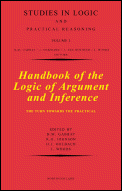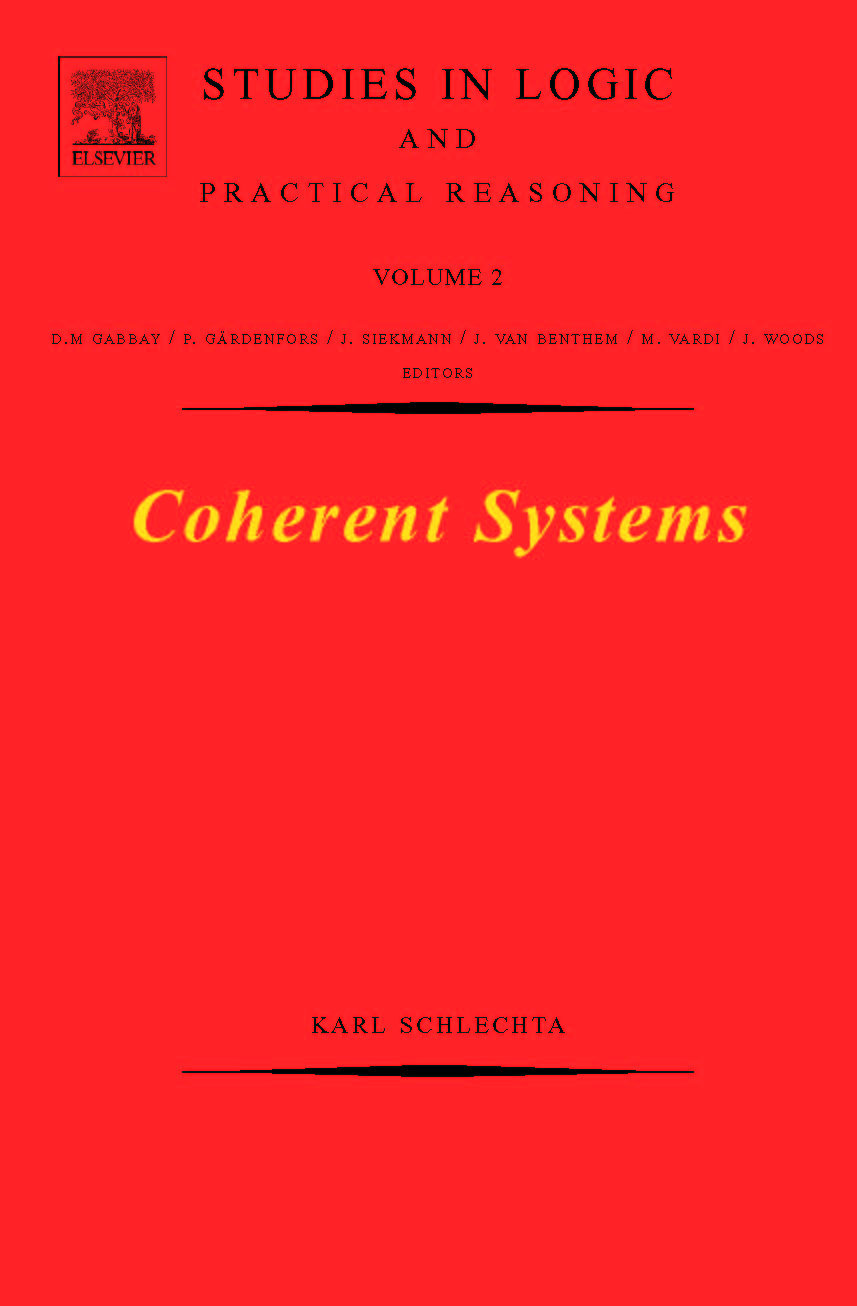

| Handbook of the Logic of Argument and Inference: The Turn Toward the Practical, volume 1 of Studies in Logic and Practical Reasoning, edited by Dov M. Gabbay, Ralph H. Johnson, Hans Jürgen Ohlbach and John Woods, Amsterdam: North-Holland, 2002. |  |
| Coherent
Systems, by Karl Schlechta, volume 2 of Studies in Logic and Practical Reasoning.
Amsterdam: Elsevier, 2004. |
 |
In Press
Forthcoming
1. Handbook of Modal Logic, edited by Patrick Blackburn, Johan van Benthem and Frank Wolter.Modal logic was born almost a century ago. Originally a branch of philosophical logic, over the last thirty years it has attracted the interest of computer scientists, mathematicians, linguists, economists, and researchers in artificial intelligence, and nowadays it is one of the most widely used logical formalisms. But because of this diversity, work in
modal logic tends to be scattered, with researchers from one field unaware of related work in another. A compact reference that outlines the shape of modern modal logic, from both theoretical and applied perspectives, would be of widespread interest. At present, no such reference exists.The Handbook of Modal Logic is intended to fill this gap. Leading researchers in modal logic and its applications will contribute articles which will collectively describe modern modal logic in theory and practice, from its more elementary aspects to its most advanced.
Table of Contents
2. Paraconsistency with no Frontiers , edited by Jean-Yves Beziau and W.A. Carnielli.
1. Introduction
2. Basic Theory
Modal Logic: semantic perspective
Modal proof theory
Complexity of modal logics
Computational modal logic
3. Advanced Theory
Modal model theory
Algebras and co-algebras
Modal decision problems
Modal consequence relations4. Variations and Extensions
First-order modal logic
Higher-order modal logic
Temporal logic
PDL and mu-calculus
Description logic
Hybrid logics
Combining modal logics
5. Applications
Mathematics
Computer Science
Artificial Intelligence
Linguistics
Game Theory
Philosophy
Table of Contents
1. Marcel Guillaume
Da Costa 1964 logical seminar: revisited
memories
2. Jean-Yves Béziau
Adventures in the paraconsistent jungle
3. Diderik Batens & Joke Meheus
Recent results by the inconsistency-adaptive
labourers
II. SYSTEMS OF PARACONSISTENT LOGIC4. Casey McGinnis
Semi-Paraconsistent Deontic Logic
5. Ross Brady
Entailment logic: a blueprint
6. Francesco Paoli
Tautological entailments
7. Toshiharu Waragai & Tomoki Shidori
A system of paraconsistent logic that has the
notion of behaving classically in terms of the law
of double negation and its relation to S5
8. Don Faust
On the structure of evidential gluts and gaps
9. Corrado Benassi & Paolo Gentilini
Paraconsistent provability logic and rational
epistemic agents
10. Fred Seymour Michael
Paraconsistency, entailment and truth
III. CONCEPTS AND TOOLS FOR PARACONSISTENT LOGICSNon-deterministic semantics for families of
11. Arnon Avron
paraconsistent logics
12. Juliana Bueno-Soler, Marcelo E. Coniglio &
Walter Carnielli
Possible-translations algebraizability
13. Joao Marcos
Ineffable inconsistencies
14. Manuel Bremer
Hypercontradictions
IV. RESULTS ABOUT PARACONSITENT LOGICS15. Ana Teresa de Castro Martins & Lilia Martins
Natural deduction and weak normalization for
the paraconsistent logic of epistemic
inconsistency
16. Alessio Moretti
A possible graphical decision procedure and
hence some new paraconsistent theorems for
the Vasil'evian logic IL2
V. PHILOSOPHICAL ASPECTS OF PARACONSISTENT LOGIC
17. Paul Wong
Reasoning and modelling: two views of
inconsistency handling
18. Hartley Slater
Dialetheias are mental confusions
19. Graham Priest
Reply to Slater
20. Hartley Slater
A rejoinder to Priest's reply on "Dialetheias are Mental Confusions"
21. Catarina Dutilh Novaes
Contradiction: the real philosophical
challenge for paraconsistent logic
22. Andres Bobenrieth M.
Paraconsistency and the consistency or
inconsistency of the world
3. Automated Reasoning with Church's Type Theory: Set Comprehension and Extensionality, Chad Brown.
Table of Contents
Preface
Chapter 1. Introduction
1.1 Goal-Directed Higher-Order Calculi
1.2 Higher-Order Automated Theorem Proving
1.3 Set Comprehension and Logical Constants
1.4 Extensionality
1.5 Compact Representations of Proofs
Chapter 2. Preliminaries
2.1 Syntax of Higher Order Logic
2.2 Sequents
2.3 Syntactic Logical Relations
Chapter 3. Semantics
3.1 Applicative Structures
3.2 Evaluations
3.3 Models
3.4 Model Isomorphisms
3.5 Model Isomorphisms
3.6 Consequences of Functionality
Chapter 4. Semantic Constructions
4.1 Possible Values
4.2 Pers Over Domains
4.3 Retraction Models
4.4 Logical Relation Frames
4.5 Models with Specified Sets
Chapter 5. Completeness
5.1 Abstract Consistency
5.2 Abstract Compatibility
5.3 Nonatomic Consistency
5.4 Abstract Consistency for Sequent Calculi
5.5 Hintikka Sets
5.6 Completeness of Elementary Sequent Calculi
5.7 Completeness of Extensional Sequent Calculi
Chapter 6. Independence and Conservation
6.1 Conservation
6.2 Equalities and Quantifiers
6.3 Retractions on Types
6.4 Boolean Logical Constants
6.5 Constants of Propositional Type
6.6 Complete Sets of Logical Constants
6.7 Cantor's Theorem
Chapter 7. Extensional Expansion Proofs
7.1 Directed Acyclic Graphs
7.2 Expansion Structures
7.3 Extensional Expansion Dags
7.4 Extensional Expansion Proofs
7.5 Further Properties of Extensional Expansion
Dags
7.6 Extensional Expansion Subdags
7.7 Construction of Extensional Expansion Dags
7.8 Deconstruction of Extensional Expansion
Dags
7.9 Soundness of Extensional Expansion Proofs
7.10 Completeness of Extensional Expansion
Proofs
Chapter 8. Lifting
8.1 Developed Extensional Expansion Dags
8.2 Substitutions
8.3 Pre-Solved Parts
8.4 Lifting Maps
8.5 Strict Expansions
8.6 Search States
8.7 Options
8.8 Completeness of Search
Chapter 9. Automated Search
9.1 The MS04-2 Search Procedure
9.2 Prenex Primitive Substitutions
9.3 Optional Connections
9.4 Part Constraints
9.5 Delaying Unification
9.6 Set Constraints
9.7 The MS03-7 Search Procedure
Chapter 10. Examples
10.1 Simple Examples
10.2 Leibniz Equality and Primitive Equality
10.3 Topology Theorems
10.4 Variants of Knaster-Tarski
Appendix A. Proofs
Bibliography
Indices